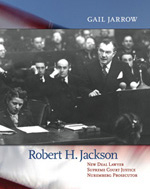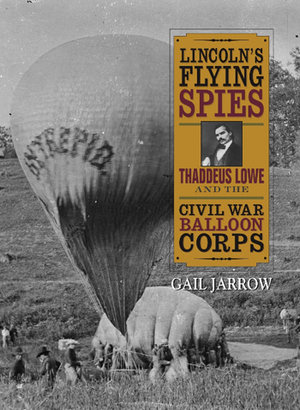RESOURCES FOR OTHER JARROW NONFICTION BOOKS
Robert h. jackson: new deal lawyer, supreme court justice, nuremberg prosecutor
Teacher's Guides
The Robert H. Jackson Center website provides teacher-created lesson plans and resources about Jackson and his work at Nuremberg and the Supreme Court.
more to explore
Robert H. Jackson
Watch video of Chief U.S. Prosecutor Robert Jackson at the Nuremberg Trial, 1945-46. collections.ushmm.org/search/catalog/irn1002256
Robert H. Jackson Center, Jamestown, New York www.roberthjackson.org/resources/
Read Jackson’s judicial opinions and articles. Listen to his recorded speeches. Watch interviews with his family, friends, and colleagues.
Roosevelt/Truman/Eisenhower Administrations
Library Web sites contain information about each president’s life and administration, including documents, speeches, and photographs. Sites have student sections with additional research sources.
Franklin D. Roosevelt Presidential Library and Museum, Hyde Park, New York www.fdrlibrary.marist.edu
Truman Presidential Museum and Library, Independence, Missouri www.trumanlibrary.org
Dwight D. Eisenhower Presidential Library and Museum, Abilene, Kansas eisenhower.archives.gov/
Supreme Court
Supreme Court of the United States, Washington, D.C. www.supremecourtus.gov
Includes history of the Supreme Court, biographies of the justices, information about recent cases and Court procedures. The Court building is open to the public. Take a tour, listen to oral arguments, and watch the justices in action.
“The Supreme Court,” PBS series www.pbs.org/wnet/supremecourt
Features history of the Court and its notable decisions, interviews with justices, and lists of print and online resourceSupreme Court Historical Society www.supremecourthistory.org
Gives overview of the Court’s history and traditions with special sections on landmark cases.U.S. Supreme Court Center www.supreme.justia.com
Contains the complete text of Supreme Court rulings. Includes links to commentary and blogs about the Court.
Oyez Project www.oyez.org
A multimedia archive of the U.S. Supreme Court. Take a virtual tour of the Supreme Court building. Listen to selected oral arguments.
Legal Information Institute, Cornell University Law School www.law.cornell.edu/supct/index.html
Provides text of Supreme Court decisions, both historic and current.
The Brown Foundation www.brownvboard.org
Features information about the 1954 Brown v. Board of Education decision.iCivics. www. icivics.org
Games and interactive activities help students learn about the Constitution, the three branches of government, and the responsibilities of citizenship. Run for president. Argue a case before the Supreme Court. Solve an international crisis. This site was established by Justice Sandra Day O'Connor.
The Nuremberg War Crimes Trial
Avalon Project at Yale Law School http://avalon.law.yale.edu/subject_menus/imt.asp
Contains complete transcript of the International Military Tribunal at Nuremberg.
United States Holocaust Memorial Museum, Washington, D.C. www.ushmm.org
Site features extensive information about the Holocaust and lists research sources. View historical photographs and film documenting the Holocaust and World War II.
Famous Trials www.famous-trials.com/
Includes an account of all Nuremberg Trials, 1945-49, by Douglas O. Linder, law professor at the University of Missouri-Kansas City School of Law. Has links to additional resources.
International Criminal Court www.icc-cpi.int
Discusses the ICC’s history, organization, and recent cases.
the printer's trial: the case of john peter zenger and the fight for a free press
activities
This book can be used to meet the Common Core and State Standards in Language Arts/English and Social Studies/U.S. History. Zenger’s 1735 trial in New York helped to form a foundation for the U.S. Constitution and later the Bill of Rights. The political issues of the Colonial period can be used as the basis for debates, opinion and explanatory writing, and research.
Recreate Zenger’s Freedom of the Press trial using as a guide James Alexander’s narrative of the trial. Have class members take roles as prosecuting and defense attorneys, judges, jurors, witnesses, and spectators. https://history.nycourts.gov/wp-content/uploads/2018/11/History_Tryal-John-Peter-Zenger.pdf
Make a list of the people involved in the Zenger case. How was each responsible for Zenger’s arrest and the outcome of his trial?
Explain the reasons behind the launching of the New-York Weekly Journal newspaper. Did the Journal’s founders succeed in their goals? Argue your position.
Read articles from the New-York Weekly Journal. What techniques did the authors use to persuade readers?
Find an example of journalism today that was started solely for political reasons. Has that journalistic effort succeeded or failed? Give proof and reasons for its success or failure.
Why has Zenger’s name come down through history as the hero of this trial? Does he deserve the fame? Are others more deserving? Support your position with evidence.
More to explore
See these sites for additional activities and instructional materials for teaching about Freedom of the Press and the Constitution:
www.billofrightsinstitute.org/
www.usconstitution.net/
www.constitutioncenter.org/
lincoln's flying spies: thaddeus lowe and the civil war balloon corps
Activities
This book has curriculum connections to Social Studies/History, Language Arts, and Science in Grades 5-12 and supports the teaching of the National Standards. It contains timeline, notes, bibliography, and lists of recommended books, places to visit, and Web sites.
The activities and questions below can be adjusted for grade level and used for writing, oral discussion, or class presentations.
U.S. HISTORY
This book covers the strategy, goals, and outcome of Civil War battles and campaigns from
April 1861 to June 1863.
Civil War: The causes. The course and character of the war.
History Activities:
Make a timeline showing when and where the Union army’s Balloon Corps operated.
Using a copy of the map in the front of the book, trace the path of the Army of the Potomac and Balloon Corps and the path of the Confederate forces from summer 1861 to summer 1863.
Give examples of situations in which the Balloon Corps helped the Union army. (Students should discuss surveillance of enemy camps, aiming artillery, map-making, battlefield observations)
Give examples of how the Confederate army reacted to the Union balloons.
What were the reasons for the disbanding of the Balloon Corps in summer 1863?
Explain why the Confederate army did not have greater success using surveillance balloons.
The images in the book were taken during the Civil War, the first war to be extensively photographed. Use the photographs and their captions to discuss:
A soldier’s life -- the uniforms and campsites
War balloons -- size and operation
The role of telegraph during the Civil War
Civil War battles -- Fort Sumter, the Seven Days Battles, and the battles of Fair Oaks/Seven Pines, Fredericksburg, ChancellorsvilleResearch a particular Civil War battle. Write a report or create a poster that shows the battle’s who, what, when, where, and why.
Research the use of manned military balloons by Europeans during the 18th & 19th centuries and by the U.S. Army in World War I.
LANGUAGE ARTS
This book is a biography of Thaddeus Lowe, the New Hampshire native who organized the Balloon Corps.
Read, understand, appreciate a biography.
Discuss the book and express opinions through written, spoken, and visual language.
Describe historic events through eyes and experiences of those who were there.
Analyze historic documents (letters, memoirs, diaries).
Language Arts Activities:
What character traits helped Thaddeus Lowe reach his goal of organizing and leading the U.S. Balloon Corps?
Using quotes in the book taken from diaries, letters, and memoirs, discuss what Union and Confederate soldiers and generals thought of Thaddeus Lowe and the Union Balloon Corps.
Pretend to be Thaddeus Lowe. Write a journal or letters to your family detailing your experiences as head of the Balloon Corps.
Read Jules Verne’s novel, The Mysterious Island. Discuss the ways the novel’s account of the Civil War balloons contrasts with their actual use by the Union and Confederate armies.
PHYSICAL SCIENCE
This book discusses hydrogen balloons and the telegraph.
Properties of matter
Chemical reactions
Science and technology
History of science
Science Activities:
Discuss how hydrogen balloons work. Compare them to hot air balloons, which are more commonly used today. Why were hot air balloons impractical during the Civil War?
Discuss how Lowe’s portable generators produced hydrogen gas. Why were the generators so important to the success of the Balloon Corps?
Discuss how the telegraph was used during the Civil War. What other methods did the aeronauts use to communicate balloon observations from the air to the ground?
Research the attempts to cross the Atlantic Ocean in a balloon, including the first successful crossing in 1978, nearly 120 years after Thaddeus Lowe tried.
More to Explore
Thaddeus Lowe
Professor Thaddeus Lowe
www.thaddeuslowe.name
Web site maintained by one of Lowe’s descendants. Contains photographs, articles, and other resources.The Legend of Pancho Barnes and the Happy Bottom Riding Club
www.legendofpanchobarnes.com
The award-winning documentary film about Thaddeus Lowe’s aviatrix granddaughter Pancho Barnes, Hollywood stunt pilot and rival of Amelia Earhart.The Ballad of Thaddeus Lowe
http://myhero.com/go/films/view.asp?film=ballad%20thaddeus%20lowe
A short animated tribute to Civil War aeronaut Lowe, by Kelly Jones.Man, Moment, Machine: Lincoln & the Flying Spying Machine, The History Channel, DVD, 2009
Video (47 min) uses interviews, archival photographs, and actors to show how hydrogen balloons helped the Union army during the Civil War.International Spy Museum, Washington, D.C.
http://www.spymuseum.org/
Fascinating exhibits about spies throughout history. See the exhibit on the Civil War sky spies.
The Civil War
The Civil War: A Film by Ken Burns.
www.pbs.org/civilwar/
PBS site for the film contains video clips, photographs, information about the war, and lists of Civil War books and Web sites.Civil War Maps. American Memory, Library of Congress.
memory.loc.gov/ammem/collections/civil_war_maps/
View Civil War maps that show battlefields, attack plans, troop movements, and fortifications.Civil War Photograph Collection, Library of Congress.
www.loc.gov/pictures/collection/cwp/
A searchable collection of 7000 Civil War images.CivilWar@Smithsonian, Smithsonian Institution, Washington, D.C.
www.civilwar.si.edu
The Smithsonian’s online collection of Civil War portraits, photographs, and artifacts. Site includes a timeline and lists of other resources about Lincoln, Civil War leaders and soldiers, and weapons.Richmond National Battlefield Park, Richmond, Virginia.
www.nps.gov/rich/
Find out more about the Peninsula Campaign of 1862, during which both sides used surveillance balloons. Visit museums and battlefield sites managed by the National Park Service.Fredericksburg and Spotsylvania National Military Park, Fredericksburg, Virginia.
www.nps.gov/frsp/index.htm
Learn about the battles of Fredericksburg and Chancellorsville at the visitor centers and battlefield walking trails.Civil War Trust
www.civilwar.org
Site includes articles about the War and its causes, biographies of key figures, photographs, and information about battlefields. View primary source documents related to the War. Check out the activities for students and teachers, links to other websites, and list of recommended books.
Ballooning
History Detectives
http://www.pbs.org/opb/historydetectives/investigation/civil-war-balloonView video and read transcripts from PBS’s History Detectives episodes about Civil War balloons, war balloons, and Civil War photography.
Albuquerque International Balloon Fiesta
www.balloonfiesta.com
Web site for the world’s largest annual balloon gathering. Short articles explain how modern hot air and gas balloons work. Reference section includes books and web sites about ballooning.


